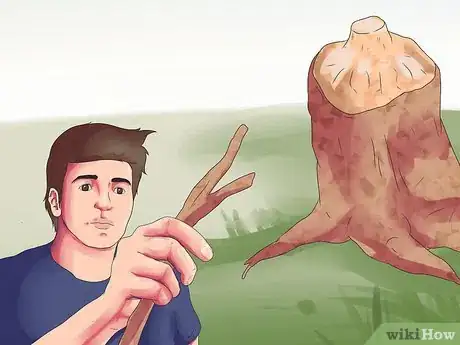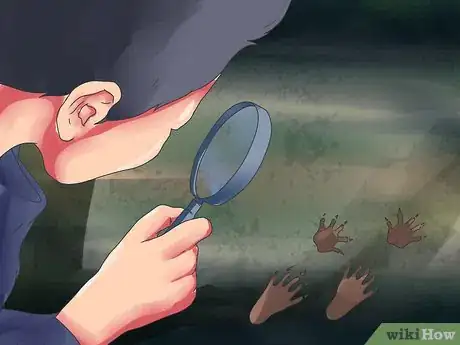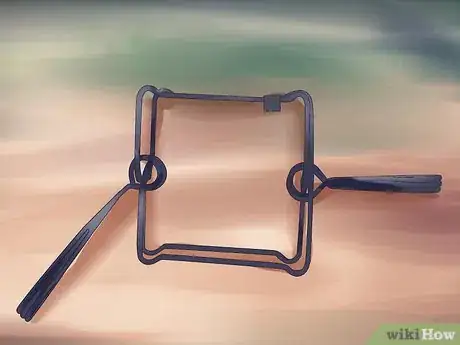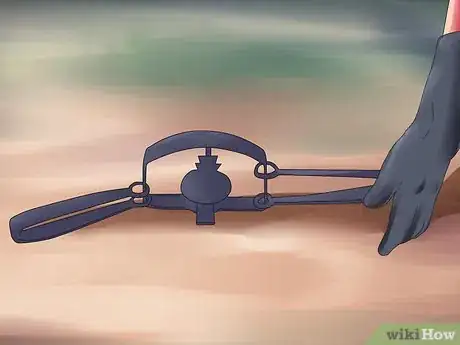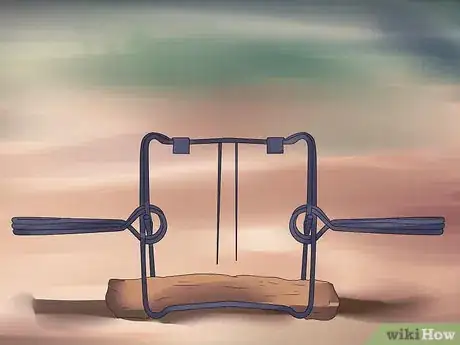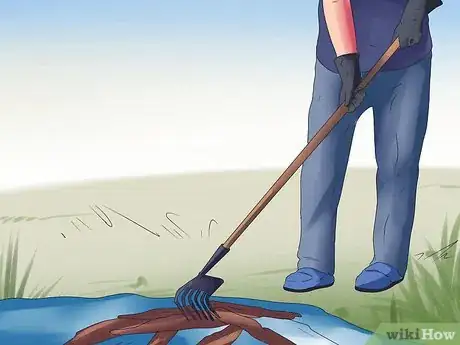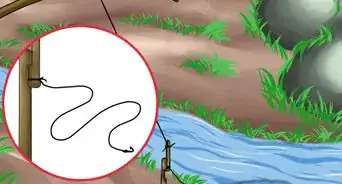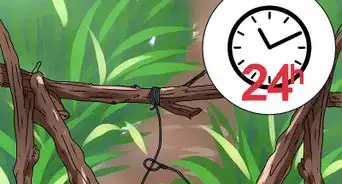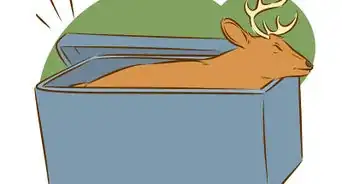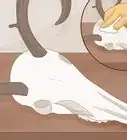X
wikiHow is a “wiki,” similar to Wikipedia, which means that many of our articles are co-written by multiple authors. To create this article, 12 people, some anonymous, worked to edit and improve it over time.
There are 9 references cited in this article, which can be found at the bottom of the page.
This article has been viewed 60,083 times.
Learn more...
Beavers can be a massive nuisance when they change the topography of an area by diverting water and damming streams. They also chop down trees with their teeth for food and to use in building the dams and beaver lodges. If you don't want to hire a professional to do your trapping for you, there are certain relatively easy ways to do it yourself.
Steps
Part 1
Part 1 of 3:
Tracking Beavers
-
1Check local hunting restrictions. There are very specific restrictions on when you can go beaver hunting, because they were almost hunted into extinction in the United States in the 1900s. Before you decide to go catching beavers, make sure that you check what the restrictions are in your area. The following restrictions are for the United States.[1]
- Zone A (northwest), beaver season is from November 1st to March 30th.
- Zone B (northeast), beaver season is from November 1st to March 30th.
- Zone C (south), beaver season is from November 1st to March 31st.
- Zone D (Mississippi River), beaver season is from the end of duck hunting season to March 15th.
- If you are a property owner who is having troubles with beavers on your property, you can usually get a permit to get rid of the pest. Go to your local wildlife regulation department (sometimes called Department of Wildlife and Game, or similar, depending on your area).
-
2Find the best areas for beavers. You want to look for the areas with the best beaver habitats, because that is where you're more likely to find beavers. This means looking for areas that are conducive to building their beaver lodges and dams and that have the right food sources.[2]
- Beavers need a year-round water source. Places where you're likely to find beavers are by streams, lakes, ponds, wetlands, and low-lying water areas like lowlands or swamps. In urban areas they are becoming more common in road-side ditches, drainage ditches, and sewage ponds.
- Beavers are herbivores, and their diet changes seasonally, so if you're tracking a beaver in the appropriate time (November to March) you're going to be looking mostly at their winter and spring diets.
- In winter, beavers prefer to eat sweet gum, ash, poplar, pines, as well as birch, willow, and aspen. Look for areas that have these types of trees in large quantities, as well as a year-round water source.
- In spring, beavers will be more likely to eat aquatic plants and the green shoots of plants, so look for areas that have a water source for the aquatic plants.
Advertisement -
3Look for beaver evidence. There will be obvious signs that a beaver is in the area when you start to look for them. They tend to cut down trees by chewing through the trunks at a 45 degree angle. This tends to give them an hour-glass shape that is pretty obvious.[3]
- Along with toppled trees you'll see a lot of wood chips, and stumps in beaver areas.
- You will also see the drams, or lodges that beavers create, on the waterside. These are usually big piles of interwoven branches on the water, with an underwater entrance. They can be up to ten feet in height and up to 5 feet (1.5 m) in width. Not all beavers live in lodges, however. Some live in burrows along the river or pond-side. if this is the case, you'll need to look for other beaver markings.
-
4Look for beaver markings. Beavers will leave certain markings in the areas they inhabit. These will be things like tracks, or scat, which can let you know that you're in the right area.
- Beaver's have unique tracks that can be difficult to discern, because their wide, flat tails and the branches that they tend to drag with them can obscure the tracks. Instead of looking for the tracks themselves, look for places where something has been dragged (like a thick branch).
- The most likely place you'll locate actual beaver tracks is in the mud at the edge of the water source (river, pond, etc.). Beaver tracks look like small, human-like hands (typically 2.5 to 3 inches long). They are 5-toed.
- You can also look for their scat, which resembles wood chips. However, beavers typically deposit their scat under water, so it's harder to find than the more obvious evidence (fallen trees, and drag trails, for example).
-
5Find a place to set the trap. There are a couple different places that work to set your beaver trap. You could find the entrance of the dam or lodge and set it there, if the water is shallow enough. Otherwise, you'll need to find a beaver path.
- Find a beaver path. Beavers, like most animals, are creatures of habit. They tend to stick to the same paths, through the water or over ground. If there's a dam that separates two ponds, set the trap on top of the dam, because the beavers will go over the dam.
- Find shallow water near the dam or lodge. Look for a narrow trough in the shallow water. These troughs tend to be empty of debris at the bottom, so they are clear for the beaver. Set up the trap in the trough. If the water is more than 10 inches, put a log across the top so that the beaver is forced to dive.
- If you locate the entrance to the beaver lodge in shallow water (12 inches or less), that's the best place to set the trap. It will be less conspicuous and will be more effective, because the beaver will have to enter or exit the lodge at that point.
Advertisement
Part 2
Part 2 of 3:
Trapping the Beavers
-
1Use a body-gripping trap. This is the best trap to use for catching beavers, especially if you're new to trapping. It's illegal to catch a beaver and relocate it alive, so your options are trying to get it to leave its area on its on, or killing it. Body-gripping traps are the best way to do that.[4]
- Conibear is considered the best body-gripping trap. It's the easiest to use and the safest to use.
-
2Prepare the trap before you set it. If you get a new trap, it will typically be coated in a lubricant that makes it dangerous to handle. To make sure that it's easy to handle, and less conspicuous when you set it, you need to soak it beforehand.
- Soak in hot soapy water, then rinse the trap. When it's been rinsed, soak the trap in a mixture of hot water and ice cream salt. Set it outside to dry a couple days before you set the trap. It will be rusted and easier to deal with, so that it will be more effective in trapping the beaver.
-
3Set the trap properly. Again, the Conibear body-gripping trap is the most effective, easiest to use, and safest trap for catching beavers. However, this means that you need to set it properly otherwise you could end up getting injured. Check the instructions that come with the trap, because not all traps are set exactly the same and the one in the substeps is a Conibear trap.[5]
- The trap consists of 2 springs (the curled wires on each side), 2 safety catches (the hooks hanging off the springs), 2 jaws (the square or rectangular body of the trap), 1 trigger (hangs down from the trap lock), and 1 trap lock (at the top of the jaws). Make sure you identify the different parts of the trap so you know how to set the trap.
-
4Get the spring set up. Extend spring so that it's pointed away from the trap. From there, grip and compress the spring. The spring creates the force that catches the animal in the trap when it triggers the trap.
-
5Set the frames properly. Pull trap frames together with one hand, while keeping the spring compressed with the other. Put a gripper over the jaws to hold them in place, or tie them with a rope.
-
6Position trap lock (also called a dog) and trigger where you want them on the frame. Set trigger in the preferred notch of the trap lock. Making sure that trigger is in the notch, grip compressed spring and release the frames slowly. If you're using a gripper or rope, release that, too.[6]
-
7Place the trap. No matter where you're setting the trap, on a water-path, in front of the den, etc., you'll need to place it upright, with the trap lock at the top. You can attach the springs to sticks to hold it upright, or tie it in place.
- You may have to build a small structure out of some branches to keep the trap upright and to block the beaver from going around the trap. Consider the area you're placing your trap and how you're going to need to set it.
-
8Check the trap. Check your trap regularly (every couple of days). You don't want the dead beaver to attract other animals, since once you've killed the creature, you should use it's pelt and meat so it doesn't go to waste.
Advertisement
Part 3
Part 3 of 3:
Reducing Beaver Damage Non-Lethally
-
1Wrap trees with chicken wire or other heavy metal sheeting or wire. Wrap up from the base at least 3 feet (0.9 m). This will keep the beavers from being able to eat or use the trees. You will need to check your trees to make sure that the beavers are leaving them alone.
- You can also make wire fences to prevent beavers from entering a specific area (especially around a pond). You can also put mesh coverings over culverts and the like to keep beavers away from them.
-
2Destroy the dam or lodge. Sometimes completely destroying the beaver's dam or lodge, as well as eliminating access to its habitat can discourage the beaver. You have to make sure that you carry away all of the dam, so that the beaver can't access it in order to rebuild.
- Use a sturdy potato rake and work from the downstream side, to completely destroy the dam or lodge.
- You will want to keep checking the dam or lodge area to make sure that the beaver is not rebuilding and that there is no material available for rebuilding.
-
3Use a repellant. There is only one repellant that has been proven to be effective in eliminating beavers and beaver damage. This is Thiram. You'll need to apply the repellant directly to the leaves and shrubs that the beaver has been using as a food source.[7]
- Again it's good to use this method in conjunction with the other methods, such as destroying the dams and lodges and then spraying the food sources with Thiram.
- There are other repellants and sprays you can use to discourage beavers from coming into the area if they haven't already, but only Thiram gets rid of them if they're already there.[8]
-
4Control the water level. There are a couple different ways to control the water level so that it doesn't become conducive to beaver habitation. You can create a drain so that the water level stays down or you can keep the water clear of debris or anything that might prevent water flow.
- Get a drain pipe by fitting two plastic sewer pipes together and perforate one of them. Depending on the volume of the water in the stream the diameter of the pipes can be 10, 15, 20 or 25 cm (4, 6, 8 or 10 in.).
- Dig a hole in the beaver dam along the original stream channel. Set three-quarters of the pipe at almost any level in the dam, and extend the perforated edge into the beaver pond (upstream). Attach a weight to one end of the pipe.
- Allow around one quarter of the pipe to extend out on the downstream side of the dam.
- Add about a 1 inch elbow or turndown to the perforated side of the pipe so that you discourage plugging of the upstream end of the pipe.
Advertisement
Community Q&A
-
QuestionWill a beaver chew its leg off to get out of the trap?
 Community AnswerNo. The trap that is mentioned snaps the beaver's back, causing the spinal cord to be cut off, and killing the animal.
Community AnswerNo. The trap that is mentioned snaps the beaver's back, causing the spinal cord to be cut off, and killing the animal.
Advertisement
Warnings
- Catching beavers may be restricted or even illegal in certain countries and regions.⧼thumbs_response⧽
- Wear protection because beavers can be dangerous, especially if you're live-trapping the beaver.⧼thumbs_response⧽
Advertisement
References
- ↑ http://dnr.wi.gov/topic/trap/dates.html
- ↑ http://georgiawildlife.com/node/741
- ↑ http://www.bear-tracker.com/beaver.html
- ↑ http://dnr.sc.gov/wildlife/beaver/images/beaver.pdf
- ↑ http://www.oneidavictor.com/trap-setting-instructions.html
- ↑ http://www.wildlife-removal.com/beavertrapping.html
- ↑ http://www.flemingoutdoors.com/beaver-trapping-tips.html
- ↑ http://www.wildlifeanimalcontrol.com/beaverrepellent.html
- ↑ http://www.dnr.sc.gov/wildlife/publications/pdf/beavercontrol.pdf
About This Article
Advertisement


